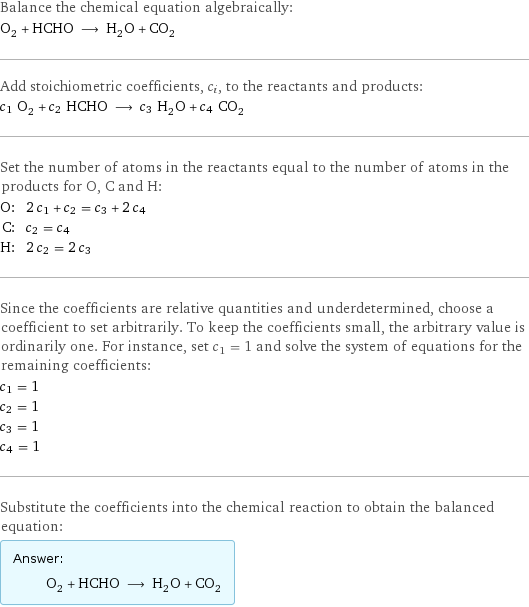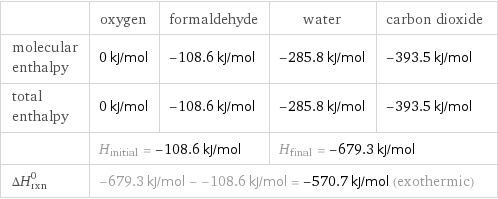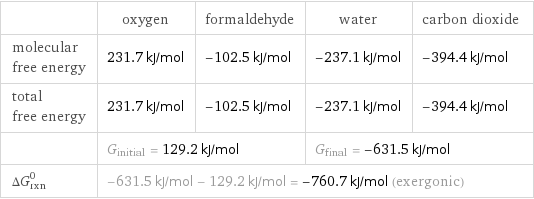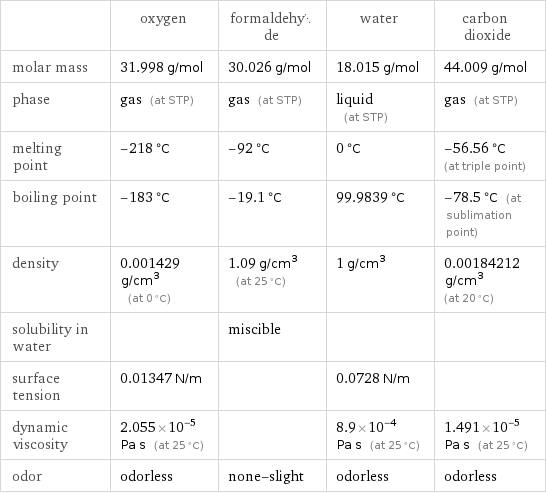Input interpretation

O_2 oxygen + HCHO formaldehyde ⟶ H_2O water + CO_2 carbon dioxide
Balanced equation

Balance the chemical equation algebraically: O_2 + HCHO ⟶ H_2O + CO_2 Add stoichiometric coefficients, c_i, to the reactants and products: c_1 O_2 + c_2 HCHO ⟶ c_3 H_2O + c_4 CO_2 Set the number of atoms in the reactants equal to the number of atoms in the products for O, C and H: O: | 2 c_1 + c_2 = c_3 + 2 c_4 C: | c_2 = c_4 H: | 2 c_2 = 2 c_3 Since the coefficients are relative quantities and underdetermined, choose a coefficient to set arbitrarily. To keep the coefficients small, the arbitrary value is ordinarily one. For instance, set c_1 = 1 and solve the system of equations for the remaining coefficients: c_1 = 1 c_2 = 1 c_3 = 1 c_4 = 1 Substitute the coefficients into the chemical reaction to obtain the balanced equation: Answer: | | O_2 + HCHO ⟶ H_2O + CO_2
Structures

+ ⟶ +
Names

oxygen + formaldehyde ⟶ water + carbon dioxide
Reaction thermodynamics
Enthalpy

| oxygen | formaldehyde | water | carbon dioxide molecular enthalpy | 0 kJ/mol | -108.6 kJ/mol | -285.8 kJ/mol | -393.5 kJ/mol total enthalpy | 0 kJ/mol | -108.6 kJ/mol | -285.8 kJ/mol | -393.5 kJ/mol | H_initial = -108.6 kJ/mol | | H_final = -679.3 kJ/mol | ΔH_rxn^0 | -679.3 kJ/mol - -108.6 kJ/mol = -570.7 kJ/mol (exothermic) | | |
Gibbs free energy

| oxygen | formaldehyde | water | carbon dioxide molecular free energy | 231.7 kJ/mol | -102.5 kJ/mol | -237.1 kJ/mol | -394.4 kJ/mol total free energy | 231.7 kJ/mol | -102.5 kJ/mol | -237.1 kJ/mol | -394.4 kJ/mol | G_initial = 129.2 kJ/mol | | G_final = -631.5 kJ/mol | ΔG_rxn^0 | -631.5 kJ/mol - 129.2 kJ/mol = -760.7 kJ/mol (exergonic) | | |
Equilibrium constant
![Construct the equilibrium constant, K, expression for: O_2 + HCHO ⟶ H_2O + CO_2 Plan: • Balance the chemical equation. • Determine the stoichiometric numbers. • Assemble the activity expression for each chemical species. • Use the activity expressions to build the equilibrium constant expression. Write the balanced chemical equation: O_2 + HCHO ⟶ H_2O + CO_2 Assign stoichiometric numbers, ν_i, using the stoichiometric coefficients, c_i, from the balanced chemical equation in the following manner: ν_i = -c_i for reactants and ν_i = c_i for products: chemical species | c_i | ν_i O_2 | 1 | -1 HCHO | 1 | -1 H_2O | 1 | 1 CO_2 | 1 | 1 Assemble the activity expressions accounting for the state of matter and ν_i: chemical species | c_i | ν_i | activity expression O_2 | 1 | -1 | ([O2])^(-1) HCHO | 1 | -1 | ([HCHO])^(-1) H_2O | 1 | 1 | [H2O] CO_2 | 1 | 1 | [CO2] The equilibrium constant symbol in the concentration basis is: K_c Mulitply the activity expressions to arrive at the K_c expression: Answer: | | K_c = ([O2])^(-1) ([HCHO])^(-1) [H2O] [CO2] = ([H2O] [CO2])/([O2] [HCHO])](../image_source/b63f5a5fde56265eaaa5cf6fd46d26ef.png)
Construct the equilibrium constant, K, expression for: O_2 + HCHO ⟶ H_2O + CO_2 Plan: • Balance the chemical equation. • Determine the stoichiometric numbers. • Assemble the activity expression for each chemical species. • Use the activity expressions to build the equilibrium constant expression. Write the balanced chemical equation: O_2 + HCHO ⟶ H_2O + CO_2 Assign stoichiometric numbers, ν_i, using the stoichiometric coefficients, c_i, from the balanced chemical equation in the following manner: ν_i = -c_i for reactants and ν_i = c_i for products: chemical species | c_i | ν_i O_2 | 1 | -1 HCHO | 1 | -1 H_2O | 1 | 1 CO_2 | 1 | 1 Assemble the activity expressions accounting for the state of matter and ν_i: chemical species | c_i | ν_i | activity expression O_2 | 1 | -1 | ([O2])^(-1) HCHO | 1 | -1 | ([HCHO])^(-1) H_2O | 1 | 1 | [H2O] CO_2 | 1 | 1 | [CO2] The equilibrium constant symbol in the concentration basis is: K_c Mulitply the activity expressions to arrive at the K_c expression: Answer: | | K_c = ([O2])^(-1) ([HCHO])^(-1) [H2O] [CO2] = ([H2O] [CO2])/([O2] [HCHO])
Rate of reaction
![Construct the rate of reaction expression for: O_2 + HCHO ⟶ H_2O + CO_2 Plan: • Balance the chemical equation. • Determine the stoichiometric numbers. • Assemble the rate term for each chemical species. • Write the rate of reaction expression. Write the balanced chemical equation: O_2 + HCHO ⟶ H_2O + CO_2 Assign stoichiometric numbers, ν_i, using the stoichiometric coefficients, c_i, from the balanced chemical equation in the following manner: ν_i = -c_i for reactants and ν_i = c_i for products: chemical species | c_i | ν_i O_2 | 1 | -1 HCHO | 1 | -1 H_2O | 1 | 1 CO_2 | 1 | 1 The rate term for each chemical species, B_i, is 1/ν_i(Δ[B_i])/(Δt) where [B_i] is the amount concentration and t is time: chemical species | c_i | ν_i | rate term O_2 | 1 | -1 | -(Δ[O2])/(Δt) HCHO | 1 | -1 | -(Δ[HCHO])/(Δt) H_2O | 1 | 1 | (Δ[H2O])/(Δt) CO_2 | 1 | 1 | (Δ[CO2])/(Δt) (for infinitesimal rate of change, replace Δ with d) Set the rate terms equal to each other to arrive at the rate expression: Answer: | | rate = -(Δ[O2])/(Δt) = -(Δ[HCHO])/(Δt) = (Δ[H2O])/(Δt) = (Δ[CO2])/(Δt) (assuming constant volume and no accumulation of intermediates or side products)](../image_source/094be84c2315d1140112741a17fa9cce.png)
Construct the rate of reaction expression for: O_2 + HCHO ⟶ H_2O + CO_2 Plan: • Balance the chemical equation. • Determine the stoichiometric numbers. • Assemble the rate term for each chemical species. • Write the rate of reaction expression. Write the balanced chemical equation: O_2 + HCHO ⟶ H_2O + CO_2 Assign stoichiometric numbers, ν_i, using the stoichiometric coefficients, c_i, from the balanced chemical equation in the following manner: ν_i = -c_i for reactants and ν_i = c_i for products: chemical species | c_i | ν_i O_2 | 1 | -1 HCHO | 1 | -1 H_2O | 1 | 1 CO_2 | 1 | 1 The rate term for each chemical species, B_i, is 1/ν_i(Δ[B_i])/(Δt) where [B_i] is the amount concentration and t is time: chemical species | c_i | ν_i | rate term O_2 | 1 | -1 | -(Δ[O2])/(Δt) HCHO | 1 | -1 | -(Δ[HCHO])/(Δt) H_2O | 1 | 1 | (Δ[H2O])/(Δt) CO_2 | 1 | 1 | (Δ[CO2])/(Δt) (for infinitesimal rate of change, replace Δ with d) Set the rate terms equal to each other to arrive at the rate expression: Answer: | | rate = -(Δ[O2])/(Δt) = -(Δ[HCHO])/(Δt) = (Δ[H2O])/(Δt) = (Δ[CO2])/(Δt) (assuming constant volume and no accumulation of intermediates or side products)
Chemical names and formulas

| oxygen | formaldehyde | water | carbon dioxide formula | O_2 | HCHO | H_2O | CO_2 Hill formula | O_2 | CH_2O | H_2O | CO_2 name | oxygen | formaldehyde | water | carbon dioxide IUPAC name | molecular oxygen | formaldehyde | water | carbon dioxide
Substance properties

| oxygen | formaldehyde | water | carbon dioxide molar mass | 31.998 g/mol | 30.026 g/mol | 18.015 g/mol | 44.009 g/mol phase | gas (at STP) | gas (at STP) | liquid (at STP) | gas (at STP) melting point | -218 °C | -92 °C | 0 °C | -56.56 °C (at triple point) boiling point | -183 °C | -19.1 °C | 99.9839 °C | -78.5 °C (at sublimation point) density | 0.001429 g/cm^3 (at 0 °C) | 1.09 g/cm^3 (at 25 °C) | 1 g/cm^3 | 0.00184212 g/cm^3 (at 20 °C) solubility in water | | miscible | | surface tension | 0.01347 N/m | | 0.0728 N/m | dynamic viscosity | 2.055×10^-5 Pa s (at 25 °C) | | 8.9×10^-4 Pa s (at 25 °C) | 1.491×10^-5 Pa s (at 25 °C) odor | odorless | none-slight | odorless | odorless
Units
